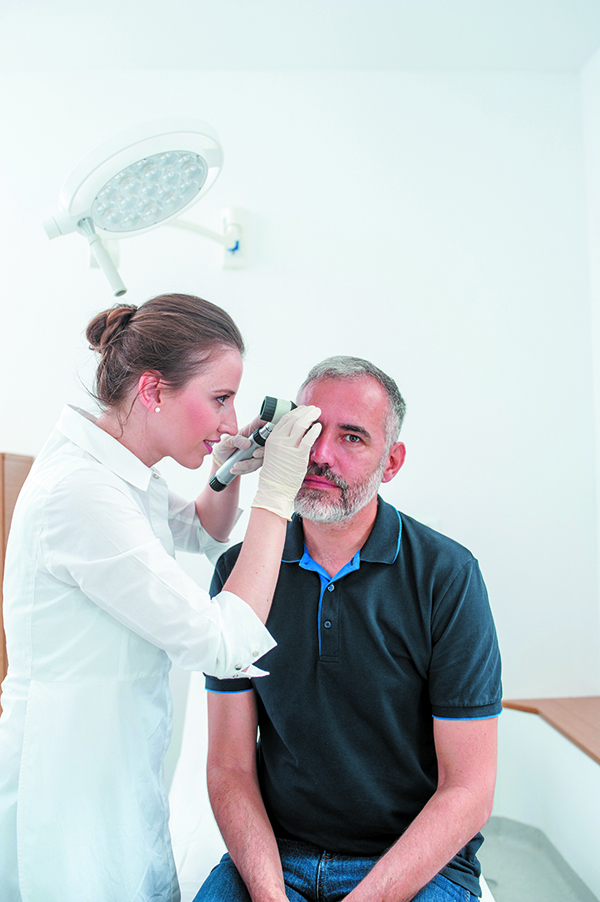Some of us age with subtle, gradual, changes in our complexions, while others show dramatic effects from a lifetime of sun exposure and other influences. But, at some point, most of us encounter unexpected bumps and spots.
So how do you know which skin spots are harmless and which should concern you enough to check in with a doctor? Here’s a quick guide to help you know.
Urgent issues
The most important reason to pay attention to the marks on your skin is to detect the earliest signs of melanoma, a cancer that can develop in the cells that give skin its color. Melanoma is less common than other types of skin cancer, but more likely to spread to other parts of the body. Risk factors include having many moles, many unusual moles (large or oddly shaped), a family history of melanoma, or fair skin, though darker-skinned people can get it too. Exposure to the sun and tanning beds raises the risk, but melanomas can also grow on skin that doesn’t get much exposure, such as the soles of the feet. Some melanomas develop from existing moles, while others arise as new growths.
Here are the signs that should prompt an immediate visit to a dermatologist:
Asymmetry. If you draw an imaginary line down the middle of the spot, do the two sides look the same or different? Melanomas may look different on each side.
Border. A melanoma may have an irregular, scalloped, or poorly defined border.
Color. A melanoma may have a mixture of colors, such as tan, brown and black, or even red, white, and blue.
Diameter. Typical melanomas are larger than a pencil eraser, about 6 millimeters, when diagnosed.
Evolving. The most concerning sign may be if a spot on your skin is getting bigger, changing color or shape, rising up from the skin, or looking different from anything else on your skin.
A melanoma doesn’t have to show all of these attributes. In some cases, it may show just one, such as rapid growth. If you have a new mole or even a bump that looks like a pimple that keeps growing, visit the dermatologist. When melanoma is caught early, the survival rates are excellent, but they drop precipitously if it spreads to other parts of the body.
Lower-risk spots
The most common forms of skin cancer are basal and squamous cell carcinomas. They are rarely life-threatening, but they can be disfiguring, so a doctor’s visit is in order if you have a spot that sounds like those described below. Anyone can develop these cancers, but they are most common in people with fair skin who have spent a lot of time in the sun.
Basal cell carcinomas most often appear the face, ears, and hands. They can look like pearly, shiny bumps with tiny blood vessels. They can be the same color as your skin or a little reddish and may have a dip in the middle. They can look like a pimple, a minor injury, or a wound that won’t heal. They can have a waxy, scar-like appearance. They may bleed, ooze, become scaly, or start to itch.
Squamous cell carcinomas most commonly appear on the face, scalp, lips, and hands, but they can also appear in the mouth, under a nail, or even inside the anus.
The earliest sign of what could become a squamous cell carcinoma is a lesion called an actinic keratosis. Usually appearing in people ages 40 or older, these are often dry, scaly pink or red patches, but they also can be brown or white. They may feel rough, sensitive, painful, itchy, prickly, and burning. They may look and feel inflamed, and they may come and go in the same location. Left untreated, these lesions can progress to squamous cell carcinoma. They may then become a raised, red bump, or even stick out like a small horn. These skin spots are highly treatable, but shouldn’t be ignored.
Benign spots
There are many benign causes of spots, lumps, and bumps that can appear— especially as we get older
- Acrochordons (skin tags) tend to grow in areas where there are skin folds. They are harmless and do not require removal, but your dermatologist can take them off if they are bothersome.
- Warts are caused by the human papilloma virus, and they can take many forms. They may be flat, cauliflower- shaped, or have finger-like projections. You can treat them at home with over-the-counter salicylic acid. If that fails, see your dermatologist for other options, such as laser therapy or cryotherapy.
- Cherry angiomas. These are small, bright red spots that are flat or slightly raised and typically appear on the trunk and extremities. They can be as small as a pinpoint and as large as a quarter inch in diameter. They most often grow on the arms, legs, or trunk, and are considered harmless.
- Age spots (also known as lentigines). These flat, oval spots are tan to dark brown. You are most likely to notice them on skin that has had heavy sun exposure, such as the back of your hands, shoulders and face. They can be lightened with creams and lotions or treated with lasers or chemical peels.
While these are all examples of benign conditions, it’s wise to always remember the adage: When in doubt, check it out.

